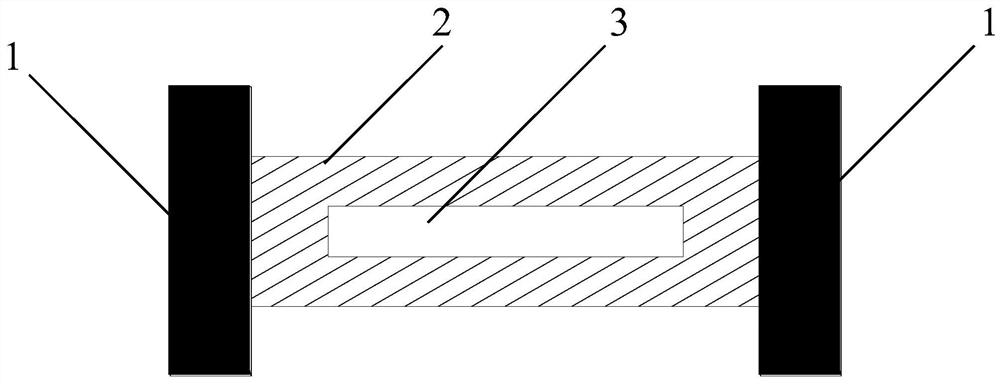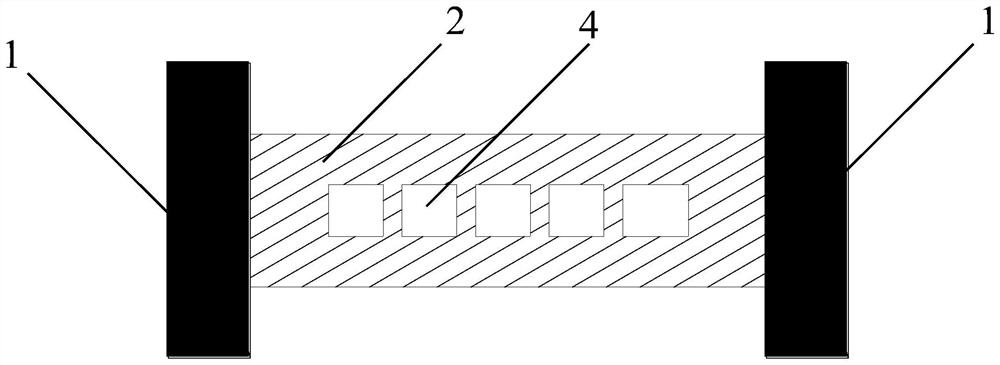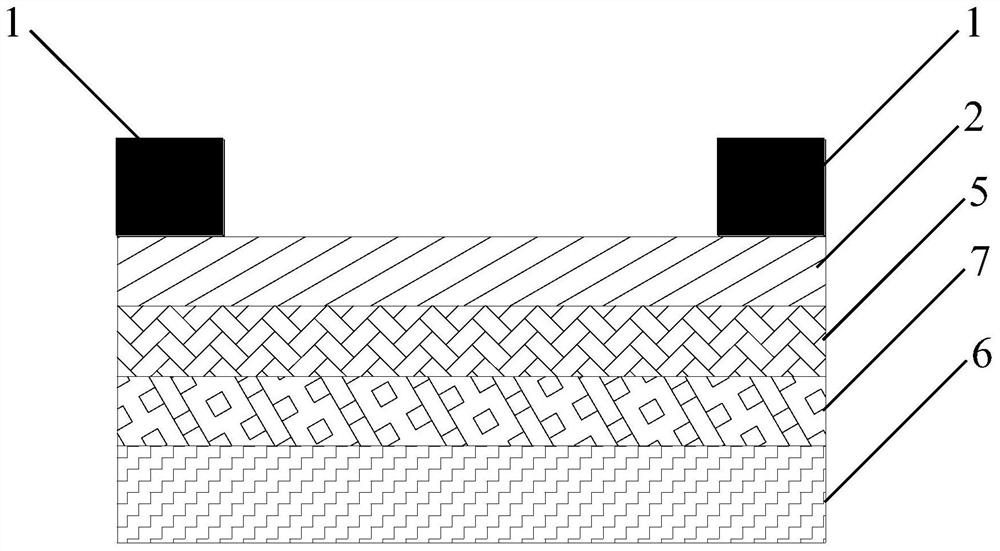A photodetection structure based on perovskite nanowires
A nanowire and perovskite technology, applied in the field of light detection structures, can solve the problems of low density of states, low detection sensitivity of weak light, etc., and achieve the effects of increased current intensity, improved detection sensitivity, and increased concentration
- Summary
- Abstract
- Description
- Claims
- Application Information
AI Technical Summary
Problems solved by technology
Method used
Image
Examples
Embodiment 1
[0023] Such as figure 1 As shown, the photodetector structure based on perovskite nanowires includes an electrode 1, a perovskite nanowire 2, a silicon dioxide layer 5, and a silicon substrate layer 6. The silicon dioxide layer 5 is placed on the silicon substrate layer 6, and the perovskite The perovskite nanowire 2 is placed on the silicon dioxide layer 5, and the two ends of the perovskite nanowire 2 are respectively connected with two identical electrodes 1. Specifically, in this embodiment, the perovskite nanowire 2 is MAPbI 3 Nanowires, the width of which is between 0.5 microns and 2 microns. Such as figure 1 As shown, the perovskite nanowire 2 has a gap 3 . The slit 3 is strip-shaped along the length direction of the perovskite nanowire 2 . The strip-shaped gap 3 divides the perovskite nanowire 2 into two relatively thinner nanowires. The width of the two thinner nanowires is similar to the wavelength of the incident light, which is beneficial to enhance the interac...
Embodiment 2
[0027] On the basis of Example 1, such as image 3 As shown, a metal film 7 is also provided between the silicon substrate layer 6 and the silicon dioxide layer 5 , and the perovskite nanowire 2 also has a gap 3 . In this way, the perovskite nanowire 2 forms a strong coupling with the metal thin film 7 and has surface plasmon resonance, which enhances the coupling between the perovskite nanowire 2 and incident light. Especially when the perovskite nanowire 2 has a slit 3 or a hole 4, a strong local electromagnetic field will be formed between the nanowire on both sides of the slit 3, the nanowire and the metal film 7, especially the nanowire and the metal film 7. The local electromagnetic fields between them are also distributed between the gaps 3, and these strong local electromagnetic fields are conducive to enhancing the coupling between the perovskite nanowires 2 and the incident light, thereby improving the detection sensitivity.
Embodiment 3
[0029] On the basis of Example 2, such as Figure 4 As shown, the metal thin film 7 is composed of no less than two strip structures 8 arranged in parallel. The arrangement direction of the strip structures 8 is perpendicular to the perovskite nanowires 2 . When the incident light is irradiated on the strip structure 8, a surface electromagnetic wave is formed on the strip structure 8, and the surface electromagnetic wave propagates along the strip structure 8. When the surface electromagnetic wave propagates to the below of the perovskite nanowire 2, the Coupled to the perovskite nanowire 2. Since these surface electromagnetic waves are excited at the non-perovskite nanowires 2, it is equivalent to increasing the area of the perovskite nanowires 2 to receive incident light, thereby increasing the intensity of received light, and further improving detection sensitivity.
PUM
| Property | Measurement | Unit |
|---|---|---|
| width | aaaaa | aaaaa |
Abstract
Description
Claims
Application Information
 Login to View More
Login to View More - R&D
- Intellectual Property
- Life Sciences
- Materials
- Tech Scout
- Unparalleled Data Quality
- Higher Quality Content
- 60% Fewer Hallucinations
Browse by: Latest US Patents, China's latest patents, Technical Efficacy Thesaurus, Application Domain, Technology Topic, Popular Technical Reports.
© 2025 PatSnap. All rights reserved.Legal|Privacy policy|Modern Slavery Act Transparency Statement|Sitemap|About US| Contact US: help@patsnap.com



